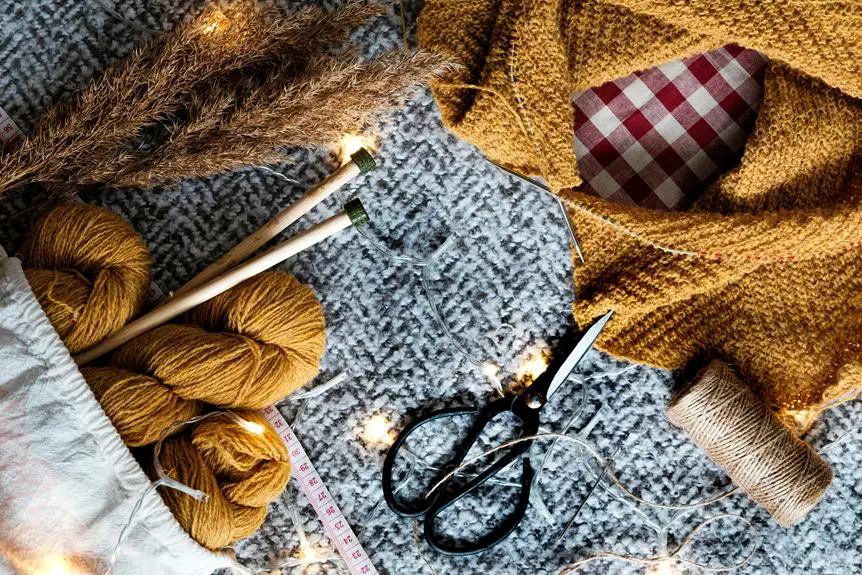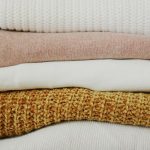When working with poly tricot, you're likely no stranger to its slippery, stretchy nature. You've probably encountered your fair share of skipped stitches, puckered seams, and frustrating fabric distortion. But what if you could master the techniques to tame this finicky fabric? By choosing the right needles and threads, adjusting your tension and stitch balance, and employing specific seam finishes and topstitching methods, you can unlock a world of smooth, professional-looking garments. But where do you start? Let's explore the best sewing techniques for poly tricot and discover how to bring out the best in this versatile fabric.
Table of Contents
Choosing the Right Needles
Poly tricot is a type of knit fabric that can be prone to skipped stitches, especially if you're using the wrong needles.
When working with poly tricot, you'll need to choose the right needles to prevent skipped stitches and ensure a smooth sewing experience.
A good option is a ballpoint needle, which has a rounded tip that allows it to easily penetrate the fabric without causing skipped stitches.
You can also use a stretch needle, which has a specialized tip that's designed to handle the elasticity of knit fabrics.
When choosing a needle, make sure to select one that's the right size for your fabric and thread. A good rule of thumb is to use a needle that's one size smaller than you'd for woven fabrics.
Selecting Suitable Threads
When selecting threads for working with poly tricot, you'll need to consider a few key factors to ensure a professional finish.
You'll want to think about the weight of the thread, as it will affect the appearance and durability of your seams.
Thread Weight Options
Selecting a thread that matches the weight of your poly tricot fabric is crucial to prevent visible stitches and ensure a professional finish. You'll want to choose a thread that's not too thick or too thin for your fabric. A thread that's too thick can be bulky and visible, while a thread that's too thin may not provide enough strength for your seams.
For lightweight poly tricot fabrics, you'll typically want to use a fine or extra-fine thread. These threads are usually labeled as 60- or 80-weight threads. They're perfect for delicate fabrics and will provide a nearly invisible stitch.
For heavier poly tricot fabrics, you can use a medium-weight thread, usually labeled as 40- or 50-weight. These threads are stronger and more durable, making them ideal for thicker fabrics or for projects that require more stability.
When in doubt, it's always a good idea to test your thread on a scrap piece of fabric before starting your project. This will give you an idea of how the thread will look and perform on your poly tricot fabric.
Thread Fiber Types
With your thread weight options in mind, now it's time to consider the type of thread fiber that will work best with your poly tricot fabric.
You'll want to choose a thread that complements the fabric's properties and ensures a strong, durable stitch. For poly tricot, it's best to use synthetic threads that mimic the fabric's elasticity and resistance to wrinkles.
You can opt for polyester or nylon threads, which are both great options for poly tricot. These threads are strong, lightweight, and resistant to abrasion, making them perfect for garments that require flexibility and durability.
If you want a thread that's a bit more heavy-duty, you can consider using a polyester-wrapped cotton thread. This type of thread offers the benefits of cotton, such as breathability and softness, while still providing the strength and durability of polyester.
When selecting a thread fiber, make sure to consider the specific requirements of your project. If you're working on a garment that will be subject to heavy wear and tear, you may want to opt for a stronger thread.
On the other hand, if you're working on a delicate project, a lighter thread may be more suitable.
Color Matching Hints
Matching your thread color to your poly tricot fabric's hue is crucial for creating a professional-looking finish, and you'll achieve the best results by choosing a thread that's either an exact match or a shade darker than the fabric. This is because poly tricot tends to reflect light, making it more noticeable if the thread color is off.
To select a suitable thread, hold the fabric against a white background and examine the color in different lighting conditions. Consider the undertones of the fabric – is it blue-based or yellow-based? This will help you choose a thread that complements the fabric's color.
When selecting a thread, don't be afraid to ask for assistance from a knowledgeable sales associate. They can help you choose a thread that's a perfect match or a shade darker.
You can also use a color-matching app or tool to help you find the perfect thread. Remember, it's always better to err on the side of caution and choose a thread that's a shade darker than the fabric, as this will create a more subtle and professional-looking finish.
Mastering Tension and Stitch
As you work with poly tricot, mastering the delicate balance of tension and stitch is key to achieving a professional-looking finish that doesn't pucker or distort.
Use a longer stitch length to prevent the fabric from bunching up or puckering, but avoid making it so long that the stitches are loose and sloppy.
Adjust your tension to match the weight and thickness of the fabric – poly tricot can be prone to stretching, so you may need to tighten your tension slightly to prevent distortion.
Keep an eye on your thread tension, as poly tricot can be prone to thread breakage if the tension is too tight.
Experiment with different stitch types, such as a zigzag or stretch stitch, to find the one that works best for your project and fabric type.
Preventing Curl and Distortion
One effective way to prevent poly tricot from curling or distorting as you sew is to use a walking foot or Teflon foot on your sewing machine. These specialized feet help to guide the fabric smoothly, reducing the likelihood of curling or distortion. You can also try using a longer stitch length, as this will help to minimize the amount of fabric stretch.
Another technique is to stabilize the fabric with a piece of interfacing or staystitching before sewing. This adds an extra layer of support to the fabric, preventing it from stretching or distorting as you sew. When cutting out your pattern pieces, make sure to use a rotary cutter and mat to ensure accurate, smooth cuts.
Additionally, you can try using a bit of steam to relax the fibers in the fabric before sewing. This will help to reduce any inherent curl or distortion in the fabric, making it easier to work with. By using these techniques, you can help to prevent poly tricot from curling or distorting as you sew.
Seam Finishes and Topstitching
When sewing with poly tricot, you'll want to give extra attention to seam finishes and topstitching to ensure a professional-looking garment that will withstand wear and tear. Since poly tricot is prone to fraying and can be slippery to work with, it's essential to choose a seam finish that will prevent the fabric from unraveling.
- Use a zigzag stitch or a serger to finish seam allowances, as this will help prevent fraying and give your seams a clean finish.
- Press your seams as you go to help the fabric lie flat and prevent distortion.
- Topstitching can be a great way to add a decorative touch to your garment, but it's also functional – it can help reinforce seams and prevent stretching.
Tips for Smooth Hemming
When it comes to hemming poly tricot, you're probably looking for a smooth finish that doesn't pucker or distort. To achieve this, you'll need to focus on three key areas: selecting the right hemming technique for your project, choosing a suitable needle that can handle the fabric's stretch, and pressing your seams to perfection.
Hemming Techniques Matter
Hemming is a crucial step in garment construction, and it's especially important when working with poly tricot, which can be prone to puckering and distortion.
To achieve a smooth hem, use a narrow hem foot or a blind hem foot to help guide the fabric and prevent puckering.
Press the hem allowance before folding it up, to create a crisp crease that will help the hem lie flat.
Use a walking foot or Teflon foot to help the fabric move smoothly under the needle, reducing the risk of bunching or dragging.
Use a stretch stitch or a zigzag stitch to finish the seam, as these stitches will allow for flexibility and prevent the seam from popping open.
Choose the Right Needle
Now that you've mastered the specialized hemming techniques to achieve a smooth, pucker-free seam on your poly tricot garments, it's time to focus on the often-overlooked but equally important tool that can make or break a professional finish: the needle.
Choosing the right needle is crucial when working with poly tricot, as it can greatly impact the quality of your stitches and the overall appearance of your garment.
When selecting a needle for poly tricot, you'll want to opt for a sharp, thin needle with a rounded point. This type of needle will help prevent skipped stitches and ensure a smooth, even seam.
A size 8 or 10 sharp/microtex needle is a good starting point, but you may need to adjust the size depending on the specific weight and weave of your fabric.
It's also important to consider the type of stitch you'll be using. For example, if you're using a zigzag stitch, you may want to use a slightly larger needle to accommodate the wider stitch width.
Pressing Is Essential
To achieve a crisp, smooth hem on your poly tricot garments, it's crucial to press your seams as you go, using a combination of steam and pressure to set the folds in place. This step can't be skipped, as it makes a huge difference in the overall finish of your project.
By pressing your seams, you'll be able to create a sharp crease that will help you achieve a professional-looking hem.
Use a hot iron with a burst of steam to help set the folds in place. Press your seams as soon as you've sewn them, while the fabric is still warm from the sewing machine.
Use a pressing cloth or a piece of scrap fabric to protect your poly tricot from scorching or melting. Press your seams in the same direction as the seam allowance to help the fabric lie flat and prevent puckering.
Frequently Asked Questions
Can I Use Poly Tricot for Quilting Projects?
You can use poly tricot for quilting projects, but it's not the best choice due to its slippery fabric and tendency to fray. However, with proper stabilization and careful handling, you can still create a beautiful quilt.
Is It Suitable for Sewing Garments With Linings?
When sewing garments with linings, you'll love working with poly tricot. It's a great choice for lining fabrics that require stretch and drape well, like jackets, dresses, or activewear, and can be easily sewn with a serger or zigzag stitch.
How to Remove Stubborn Poly Tricot Wrinkles?
When tackling wrinkles, you'll find that using steam with a hot iron works best. Don't scorch the fabric, though – test a small area first. You'll also need to press the wrong side of the fabric to avoid damage.
Can Poly Tricot Be Dyed or Painted?
You're wondering if poly tricot can be dyed or painted. Generally, poly tricot can be dyed, but it's essential to check the fabric's care label first. Some poly tricots may require special dye or painting techniques.
Can I Sew Poly Tricot on an Overlock Machine?
You can sew poly tricot on an overlock machine, but you'll need to adjust the tension and stitch length. Use a sharp needle, a walking foot or Teflon foot, and a lower presser foot pressure to prevent bunching.
- How Does Ring Spun Cotton Affect Garment Fit and Shape Retention? - August 13, 2024
- What Are the Challenges in Producing Ring Spun Cotton? - August 13, 2024
- Is Ring Spun Cotton Suitable for Plus-Size Clothing? - August 13, 2024







